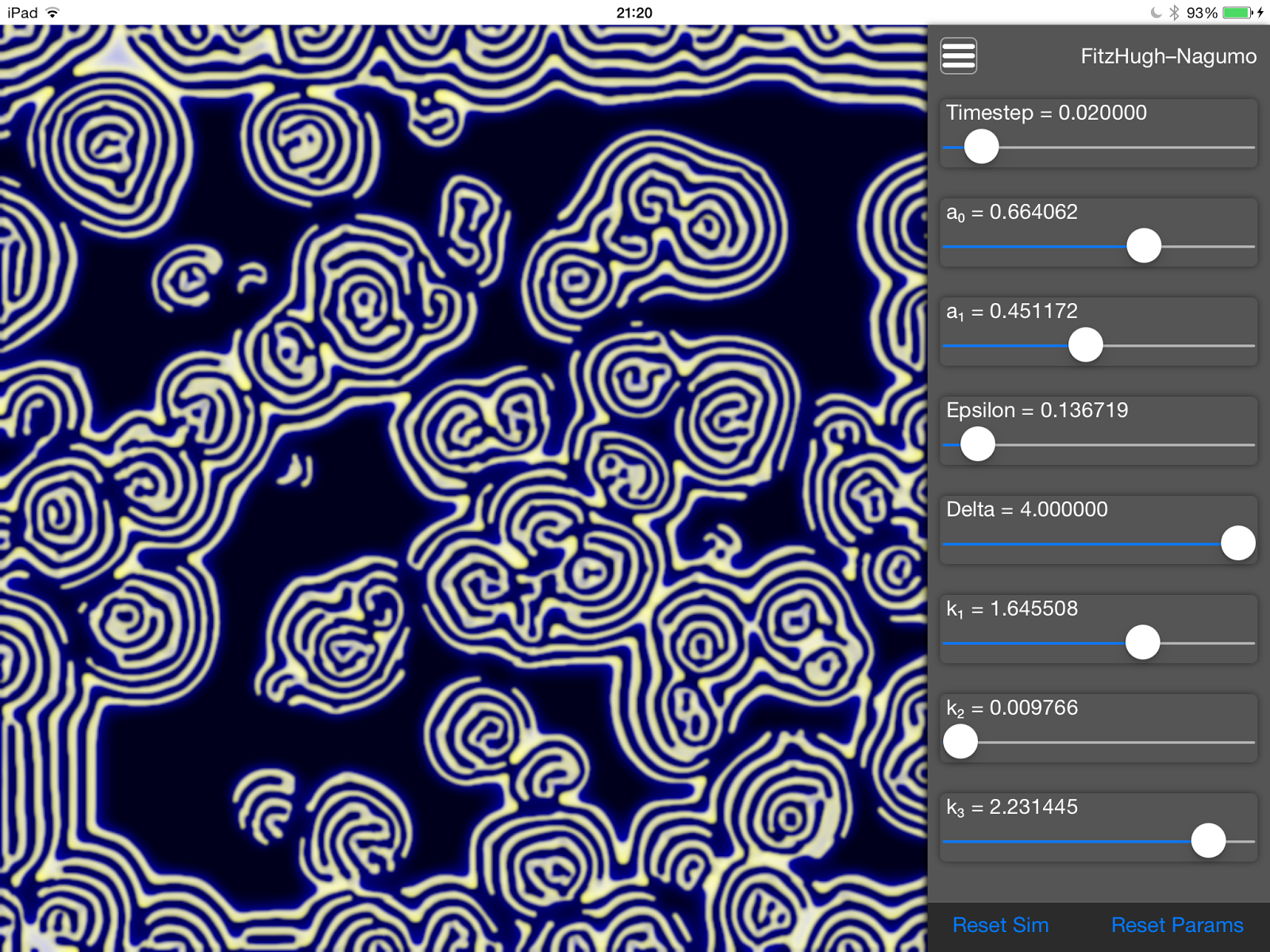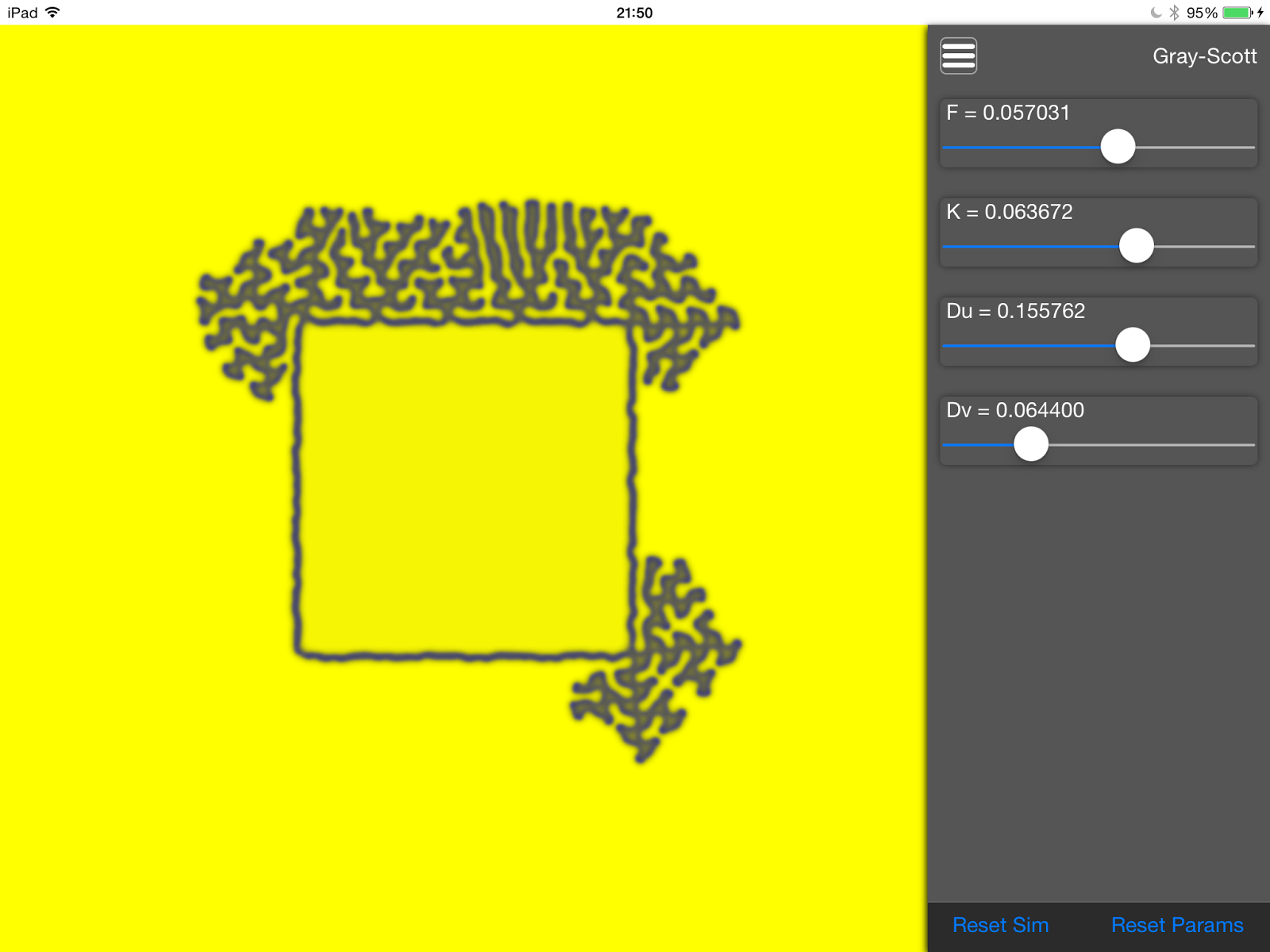Я потратил некоторое время на работу над своим приложением для имитации диффузии реакций на iPad, написанным на языке Swift с использованием технологии Apple Metal. Помимо добавления еще нескольких моделей: Грея-Скотта и Белоусова-Жаботинского , я настроил код так, что я получаю около 1000 решающих итераций в секунду на iPad Air 2.
Функция applyFilter () внутри моего контроллера представления теперь добавляет несколько команд к кодировщику команд при каждом вызове и только после фиксации нескольких вызовов записывает полученную текстуру в экземпляр UIImage, а затем в UIImageView. Различные модели диффузии реакции определяют свое собственное количество итераций на кадр, поэтому решающая часть applyFilter () теперь выглядит следующим образом:
let commandBuffer = commandQueue.commandBuffer()
let commandEncoder = commandBuffer.computeCommandEncoder()
commandEncoder.setComputePipelineState(pipelineState)
var buffer: MTLBuffer = device.newBufferWithBytes(&reactionDiffusionModel.reactionDiffusionStruct, length: sizeof(ReactionDiffusionParameters), options: nil)
commandEncoder.setBuffer(buffer, offset: 0, atIndex: 0)
commandQueue = device.newCommandQueue()
for _ in 0 ... reactionDiffusionModel.iterationsPerFrame
{
if useTextureAForInput
{
commandEncoder.setTexture(textureA, atIndex: 0)
commandEncoder.setTexture(textureB, atIndex: 1)
}
else
{
commandEncoder.setTexture(textureB, atIndex: 0)
commandEncoder.setTexture(textureA, atIndex: 1)
}
commandEncoder.dispatchThreadgroups(threadGroups, threadsPerThreadgroup: threadGroupCount)
useTextureAForInput = !useTextureAForInput
}
commandEncoder.endEncoding()
commandBuffer.commit()
commandBuffer.waitUntilCompleted()
Поскольку приложение колеблется со скоростью 50 кадров в секунду, а две модели запрашивают 20 итераций на кадр, это 1000 решающих итераций в секунду на сетке 640×640, что, на мой взгляд, впечатляет. Я даже коснулся 60 кадров в секунду или 1200 итераций в секунду!
Первая новая модель, которую я добавил, — это симуляция знаменитых химических реакций Белоусова-Жаботинского с характерными спиральными волновыми фронтами:
Функция ядра Metal для этого довольно проста и демонстрирует использование циклов for внутри кода GPU:
kernel void belousovZhabotinskyShader(texture2d<float, access::read> inTexture [[texture(0)]],
texture2d<float, access::write> outTexture [[texture(1)]],
constant ReactionDiffusionParameters ¶ms [[buffer(0)]],
uint2 gid [[thread_position_in_grid]])
{
float3 accumColor = inTexture.read(gid).rgb;
for (int j = -1; j <= 1; j++)
{
for (int i = -1; i <= 1; i++)
{
uint2 kernelIndex(gid.x + i, gid.y + j);
accumColor += inTexture.read(kernelIndex).rgb;
}
}
accumColor.rgb = accumColor.rgb / 9.0f;
float a = accumColor.r + accumColor.r * (params.alpha * params.gamma * accumColor.g) - accumColor.b;
float b = accumColor.g + accumColor.g * ((params.beta * accumColor.b) - (params.alpha * accumColor.r));
float c = accumColor.b + accumColor.b * ((params.gamma * accumColor.r) - (params.beta * accumColor.g));
float4 outColor(a, b, c, 1);
outTexture.write(outColor, gid);
}
The second model I’ve added is Gray-Scott which is probably the most well known of all reaction diffusion models and can exhibit phenomena such as solitons, bifurcation and coral type patterns:
Again, the kernel function contains little more that some pretty basic arithmetic:
kernel void grayScottShader(texture2d<float, access::read> inTexture [[texture(0)]],
texture2d<float, access::write> outTexture [[texture(1)]],
constant ReactionDiffusionParameters ¶ms [[buffer(0)]],
uint2 gid [[thread_position_in_grid]])
{
const uint2 northIndex(gid.x, gid.y - 1);
const uint2 southIndex(gid.x, gid.y + 1);
const uint2 westIndex(gid.x - 1, gid.y);
const uint2 eastIndex(gid.x + 1, gid.y);
const float3 northColor = inTexture.read(northIndex).rgb;
const float3 southColor = inTexture.read(southIndex).rgb;
const float3 westColor = inTexture.read(westIndex).rgb;
const float3 eastColor = inTexture.read(eastIndex).rgb;
const float3 thisColor = inTexture.read(gid).rgb;
const float2 laplacian = (northColor.rb + southColor.rb + westColor.rb + eastColor.rb) - (4.0 * thisColor.rb);
const float reactionRate = thisColor.r * thisColor.b * thisColor.b;
const float u = thisColor.r + (params.Du * laplacian.r) - reactionRate + params.F * (1.0 - thisColor.r);
const float v = thisColor.b + (params.Dv * laplacian.g) + reactionRate - (params.F + params.K) * thisColor.b;
const float4 outColor(u, u, v, 1);
outTexture.write(outColor, gid);
}
The parameter editor panel on the right is fully dynamic. Each different model contains an array of its field names which is used inside the ReactionDiffusionEditor‘s createUserInterface() method to add a new ParameterWidget (basically a slider and a label) for each parameter:
parameterWidgets = [ParameterWidget]()
for fieldName in reactionDiffusionModel.fieldNames
{
let widget = ParameterWidget(frame: CGRectZero)
parameterWidgets.append(widget)
widget.minimumValue = reactionDiffusionModel.getMinMaxForFieldName(fieldName).min
widget.maximumValue = reactionDiffusionModel.getMinMaxForFieldName(fieldName).max
widget.value = reactionDiffusionModel.getValueForFieldName(fieldName)
widget.reactionDiffusionFieldName = fieldName
widget.addTarget(self, action: "widgetChangeHandler:", forControlEvents: UIControlEvents.ValueChanged)
addSubview(widget)
}
Currently, my implementation of these three models could do with improvement. Swift doesn’t support reflection and I can’t, for example, get and set values in the models via square brackets (e.g x = model[«propertyName»] ). This has lead to some pretty hefty switch statements inside my ReactionDiffusionBase class:
func setValueForFieldName(fieldName: ReactionDiffusionFieldNames, value: Float)
{
switch(fieldName)
{
case .timestep:
reactionDiffusionStruct.timestep = value
case .a0:
reactionDiffusionStruct.a0 = value
case .a1:
reactionDiffusionStruct.a1 = value
case .epsilon:
reactionDiffusionStruct.epsilon = value
[...]
This application will probably form my first Swift based submission to the App Store. Since Ready, the giant on whose shoulder I stand, has its code available under GNU’s General Public License, I plan to do the same myself.
However, there’s still lots to do. My next step, which is something I’ve been planning to look at for months, is to implement Core Data for persistence and saving parameter settings. In the meantime, my source code is all available atmy Git Hub repository.


